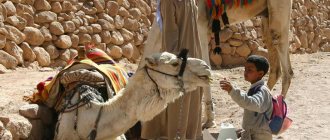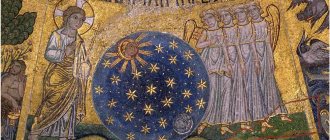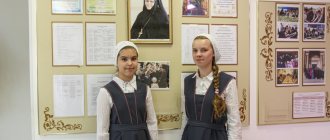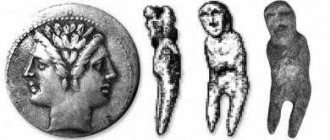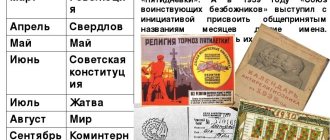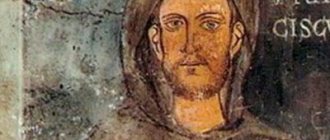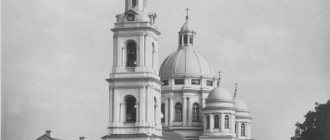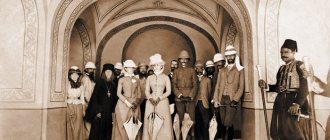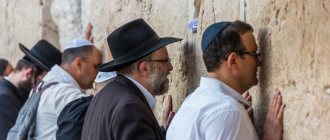ARAB,
(1) the indigenous people of the Middle East and northern Africa who speak the Arabic language and identify with Arab culture;
(2) Arabic-speaking desert nomads, Bedouins. The second meaning of the term is older, since the term Arabs first began to be used to designate the nomads of northern Arabia already in the 9th century. BC. The first meaning, a broader one, is more applicable to modern realities and corresponds to the practice of its use by the majority of Arabs. Also on topic:
NEAR AND MIDDLE EAST
Countries whose majority population is Arab in the broad sense form in their unity what has come to be called today the Arab world. In northern Africa these are Mauritania, Morocco, Algeria, Tunisia, Libya, Sudan and Egypt, in western Asia - Jordan, Syria, Lebanon and Iraq; in Arabia - Saudi Arabia, Yemen and a number of other coastal states. There is also a small Arab population in Israel. The Arab world has almost 130 million people, of which 116 million are Arabs.
However, the population of the Arab world does not have a common origin. Although the early history of Arab culture was associated with the Arabian Peninsula, over the centuries many other peoples were Arabized through the adoption of the Arabic language and Arabic culture. For almost all of them, Arabization came through Islam, the main religion of the Arab world. Arabs are as diverse in their physical characteristics as they are in their ethnic origin. There is no Arab "racial type". Some Arabs fit the stereotypical description of being thin with an aquiline nose, dark skin and black hair, but these features are not typical. Negroid Arabs are similar in appearance to sub-Saharan Africans, and the light-skinned Arabs of the Maghreb are often physically almost indistinguishable from most Europeans.
Arabs are divided into three main groups: Bedouin pastoralists engaged in breeding sheep, goats or camels, peasant farmers and urban residents. In addition, there are several small groups that lead a different lifestyle. Some Arabs live in villages, farming for a few months of the year and migrating with their animals the rest of the year. One such group is the Sudanese Baggara pastoralists. The Arabs of the Tigris and Euphrates delta swamps are fishermen and hunters; The main occupation of the inhabitants of coastal Arab villages, especially on the Red Sea, is sea fishing.
Having long served as an arena for the mixing of different cultures, trade and other contacts between three continents, the Arab world also includes a number of non-Arab minorities. Although many of them have been significantly influenced by Arabs, none of them consider themselves Arabs. Such minorities include the descendants of the pre-Arab peoples of northern Africa, for example, the Berbers and Tuaregs, the Kurds in Iraq, who speak a language related to Persian, as well as Jews, Armenians and some peoples of the geographical region of Sudan. Copts, the Christians of Egypt, also speak Arabic, but consider themselves to be original pre-Arab Egyptians.
BEDOUIN HAZARDSERS
Most Bedouins live in Arabia and the neighboring desert regions of Jordan, Syria and Iraq, but some Bedouins who insist on their Arab origin live in Egypt and the northern Sahara. The exact number of Bedouins is unknown, since no serious attempt has been made to conduct a census of these nomads. According to rough estimates, their number ranges from 4 to 5 million people.
The image of the Bedouin, often considered the most colorful figure among the Arabs, has been largely romanticized by Europeans and other Arabs. Many see the Bedouins as the “purest” Arabs, until the 20th century. who preserved the lifestyle of their ancestors unchanged. In reality, they, like most peoples, are subject to continuous external influences and changes in the course of their history.
Ancient world
Arabs live not only in Africa and the Middle East. More precisely, the first ancestors of this group of peoples (and the Arabs are precisely a group of peoples) settled on the Arabian Peninsula.
And the first Arab states began to appear in the second half of the second millennium BC. Moreover, even then it was believed that where the Arabs live, in which country, is not so important, the state will be one of the most developed. Ancient Rome and the new Europe of dark times were still very far away from them.
Bedouin Society.
Bedouins lead a strictly tribal lifestyle. The Bedouin tribe consists of several groups that consider themselves related by kinship through the male line and descended from a common male ancestor.
Tribes can have anywhere from a few hundred to fifty thousand members. Each group of the tribe is divided into small subgroups with their own names with their own common ancestors, etc. up to a subdivision of several families called “hamulah”. Some of the largest tribes have up to five or six levels of such subgroups. "Hamula" consists of a number of closely related families, this could be a group of brothers or cousins with their families, living together, herding their livestock together and staying together when migrating. A family is the smallest social unit consisting of a man, his wife or wives, their children, and sometimes including the wives and children of that man's sons.
The organization of the Bedouin tribe is fluid. Its parts often bud off and join again, and from time to time strangers join the tribe. But at the same time, the very idea of kinship remains unchanged, and genealogies are transformed through the invention of new kinship ties and in other ways in accordance with changes occurring in the composition of the tribe or its divisions.
The tribe and each of its parts is headed by a sheikh, considered the eldest in wisdom and experience. In the largest divisions, the position of sheikh can be inherited within certain families. Sheikhs at all levels exercise governance together with a council of adult men.
Bedouins prefer marriages within the hamula. Often these are consanguineous marriages, since all people of the same generation in the “hamul” are cousins. Ideally, marriages are arranged by the couple's parents, and the bride's "dowry" is provided by the groom's family. Despite these customs, Bedouin poetry is rich in stories of secret love and elopements with lovers.
Economic life.
Bedouins lead a nomadic lifestyle. In winter, when there is little rain, the “Khamuls” constantly migrate with their herds and flocks across the desert in search of water and pasture. Most of them adhere to a regular sequence in visiting certain wells and oases, i.e. areas of fertility in lifeless desert spaces. In the completely dry summer, the “hamuls” gather near tribal wells, where the water supply is more reliable. Each tribe and its subdivisions are forced to defend their grazing lands, and they often have to fight for land and water rights. Some Bedouin sheikhs own entire agricultural areas, receiving tribute from them in addition to their usual means of subsistence.
The Bedouins recognize two main activities - camel rearing and sheep and goat rearing. Camel breeders consider themselves superior to sheep breeders, and sometimes the latter sometimes pay tribute to the former. Sheep farmers often maintain close relationships with residents of villages and towns, sometimes working as shepherds for them. Camel breeders, who consider themselves the only true Arabs, try not to resort to this method of activity, seeing in it a humiliation of their dignity. For all Bedouins, the camel is a very valuable animal both for riding and for transporting goods. This animal supplies Bedouin camel breeders with milk for food and wool for making fabric, and also serves as a valuable item of trade.
Necessity forces the Bedouins to produce part of the necessary food products themselves, but usually they consider this kind of work degrading and therefore enter into barter relations with the rural and urban population, offering skins, wool, meat and milk in exchange for grain, dates, coffee and others products, as well as factory fabrics (with which they supplement their own production), metal utensils, tools, firearms and ammunition. Bedouins use money little.
Since all their belongings must easily fit on animals for frequent migrations, the Bedouins use very little furniture. Their tents are quickly disassembled and consist of wide panels of knitted sheep's wool, laid on a frame of poles and poles.
Bedouin men.
Bedouin men take care of animals and manage migration operations. They love hunting and fighting various animals, achieving great skill in this. They often find themselves involved in intertribal and internecine disputes related not only to issues of property (for example, water rights), but also to issues of honor. The Bedouins, like most other Arabs, are very sensitive to issues of honor and dignity; their infringement is considered a serious insult and can lead to bloodshed.
Cases of bloodshed are also associated with attacks on caravans and villages for the purpose of robbery or extortion of payment for so-called “protection”. However, in recent times, as planes and trucks have replaced camel caravans as the main form of transport, and the police forces of Middle Eastern governments have become more effective, such raids and attacks are becoming more rare.
The greatest pride of a Bedouin man is his horse. The famous Arabian horse is used, however, mainly for racing and light walking and never for hard work. It is poorly adapted to desert conditions and serves mainly as an object of prestige, available only to those men who can afford this luxury.
Folklore
The folklore of the Arab people excites the minds of science fiction writers and fantasy lovers. There is a whole doctrine dedicated to genies - jinnology. In Islam, jinn are perceived as demons created from fire. Man was created from clay, and angels from light. Jinn are mortal, but can live for hundreds of years. The genie must eat, it tends to get close to people and even marry people. Among the supernatural abilities that the genies possessed were gaining invisibility, turning into an animal, a plant, or another person. Jinns are usually divided into good and evil. The first accepted Islam, remaining submissive to Allah. The evil ones turned out to be infidels, but both types of jinn are dangerous to humans. The greatest threat was posed by the marids and ifrits, thirsty for blood. The Arabs believed (some believe even now) that ghouls—huge, man-eating werewolves—were introduced into cemeteries. Jinns accompanied man throughout his life, so people always warned each other about the danger of encountering them. For protection, the Muslim turned to Allah to warn against attacks by demons. Protective amulets were often used; one of the most popular was the “Palm of Fatima,” which was a copper palm with a blue bead. Fatima was the daughter of the Prophet Muhammad, and the amulet named after her, according to Arab belief, was supposed to protect against the evil eye. It was the evil eye that was considered the most terrible phenomenon. The source of the evil eye could be flattering speech or the rudeness of the interlocutor. The fear of the evil eye influenced the way of life of the Arabs. This is manifested in clothing and the desire to preserve family secrets. Arabs perceive dreams as a unique phenomenon. The first dream book dates back to the 11th century. The Koran says that it is forbidden to lie about dreams, so inventing and conjecturing a dream was prohibited. It was allowed to tell fortunes by turning to the elders, who could “read” the dream. A lot of attention was paid to fortune telling, primarily focusing on birds. It was not worth getting involved in fortune-telling rituals, as this could lead to magic. It was believed that white magic was the destiny of a pious person. She was favored by angels, good genies. An inexperienced person could quickly come to black magic, capable of realizing secret and dark desires. The evil magician was helped by the devils, who brought trouble, not only on those around him, but also on himself. These features of the worldview appeared in pre-Islamic times, and they have survived to this day.
Cloth.
There is considerable regional variation in Bedouin clothing style. For West Africa, men's outerwear with a hood - "gellab" and a robe also with a hood - "burnus" are typical. Further to the east, Bedouin men wear a long-skirted robe, similar to a nightgown, called a galabaya, and on top of it a spacious robe, open at the front, called an aba; for those who have more contact with the villages, a European-style jacket is more typical. Men wear a special headdress - “keffiyeh”, secured on the head with a cord ring - “agalem”. The aba and keffiyeh can be worn loosely or wrapped around the body and head for protection from the elements. Women wear clothes resembling "galabaya" or dresses with a defined bodice. In addition, they can wear loose bloomers and a variety of jackets or different types of aba. Women's hair is always covered with a scarf. Among some Bedouins, women may also wear a “haik” - a special curtain for the face, and in other groups, when an unfamiliar man appears, women simply cover their faces with part of their headscarf.
Religion.
Among the Bedouins there are both Christians and Shia Muslims, but the majority are nominally either Wahhabi or Sunni Muslims. Bedouins are not as religious as Muslims in villages and cities, but they regularly perform the five daily prayers prescribed by Islam. Because most Bedouins are illiterate, they cannot read the Koran themselves and must rely on oral transmission of religious ideas. Along with many people in villages and towns, they share a belief in the evil eye and evil spirits as the cause of illness and misfortune, and in the healing and protective powers of the tombs of various Muslim saints.
Life
- The foundations of morality, culture, and social life are set out in Sharia. The formation of Sharia instructions took place in the 7th century. Sharia obliges every Muslim to fast, read prayers, and perform rituals. It was prescribed to perform charity;
- Eating food, sleeping daily, and getting married are not encouraged in any way, but they are not prohibited either. Shariah does not approve of enjoying earthly life, for example, eating food. The consumption of wine, pork, gambling, witchcraft and usury were prohibited. Sharia has long been strictly observed, with the exception of the consumption of wine, which the townspeople loved very much. Villagers tried to strictly observe the norms;
- Marriage is considered one of the most important events in the life of every person. Divorce, inheritance, and other issues related to marriage are created on the basis of the traditions of pre-Islamic society and the teachings of the Koran. The significance of the birth of a son was incredibly great - it was believed that only after the birth of a boy does a man become a full-fledged person. The Koran ordered to cultivate in sons valor, the ability to answer for a word, kindness and generosity;
- Islam encourages the freeing of a slave. A Muslim who freed a person from slavery became pious. However, such an act was rarely performed, because the merchants relied entirely on the slave trade.
ARAB PEASANTS
About 70% of Arabs live in villages. Most villagers are farmers, called fellahin in Arabic, but there are also masons, carpenters, blacksmiths, shepherds, fishermen, shopkeepers and other professions. Village houses made of adobe brick or stone are built closely together without any clearly discernible plan. Around the houses there are fields, gardens and vineyards. The degree of soil fertility varies everywhere, but the lack of water is a widespread phenomenon, so irrigation is required for survival. The big problem in the village is poverty, which is very slowly giving way to the effects of modern social reforms and technological changes.
Village farming.
The most important crops grown in the villages are grains - wheat and sorghum, with bread being the main food product. Vegetables are grown wherever possible. Other important crops in different regions are dates in the desert oases, citrus fruits on the Lebanese coast, figs, grapes, olives, apricots, almonds and other fruits in the foothills and other areas where water is more abundant. In some regions, particularly Egypt, cotton is an important cash crop.
Arab farmers use many ingenious ways to conserve and distribute their limited water supplies. In some cases, they channel the water of natural streams into a complex system of canals and sluices, through which they release the water to entitled users. Water wheels can be used to lift water from one level to another. In recent years, dams have been created for large-scale irrigation systems and hydroelectricity production.
Some farmers, especially in mountainous areas, are independent land owners, while the majority of fellahin are tenants who must give a significant part of the produced product to the land owners. Usually such landowners are city dwellers, but some powerful Bedouin sheikhs are also large landowners. Some landowners provide farmers with modern agricultural equipment, but most are very conservative. The ownership of land by non-resident owners is a serious social problem in the Arab world, which many governments are trying to solve in different ways.
Villagers often maintain close relations with the Bedouins and with the townspeople. Peasants exchange their products with them for services, goods or money. Some farmers are recent immigrants from the Bedouins and may have family ties to them. An even more important trend is the constant migration of farmers to cities in search of better-paying jobs. Some peasants move alternately between the village and the city, but the permanent urban population includes many people born in the villages and maintaining their connections with them. The active growth of schooling observed in Arab villages in the 20th century served as a factor in increasing the desire of rural residents to live in the city.
Tourism in Dubai
Now the United Arab Emirates attracts tourists from all over the world, but, of course, the center of attraction is Dubai.
This city has everything: any vacationer can satisfy their desires, even ski lovers will find a place here. The best beaches, shops and entertainment centers. The most famous object not only in Dubai, but throughout the UAE, is the Burj Khalifa. This is the tallest building in the world, reaching a height of 830 meters. Inside this massive structure are retail spaces, offices, apartments, hotels and much more.
The largest water park in the world is also located in Dubai. Thousands of different specimens of animals and fish live here. Entering the aquarium, you are immersed in the world of a fairy tale, you feel like an inhabitant of the sea world.
In this city, everything is always the biggest and biggest. The largest and most beautiful artificial archipelago “Mir” is located here. The outlines of the island copy the contours of our planet. The views from the top are magnificent, so it's worth taking a helicopter tour.
Thus, the Arab world is a fascinating history, culture and modern way of life. Everyone should get acquainted with the peculiarities of this people, go to the states where Arabs live for recreation and entertainment, because this is an amazing and unique phenomenon on planet Earth.
Rural society.
Most households in an Arab village consist of a married couple and their children. Some households may also include sons' wives and their children. However, adult brothers and closely related cousins and their families most often live nearby. As with the Bedouins, several families form a "hamula". Preference is given to marriages within the village. Muslim Arabs also marry within the “hamula”, i.e. between cousins and cousins. Many Arab peasants are members of large tribal groups whose membership spans many different villages. Several such tribes trace their origins to the Bedouins.
Most Arab peasants have a deep sense of belonging to their village, whose inhabitants usually help each other in case of external threat. They are also united by religious holidays or funerals. Most of the time, however, villagers find themselves divided into separate factions, and there is little cooperation in most activities affecting the community as a whole.
Our answer
What should Christians do with this knowledge?
(1) Do not mistake every Arab you meet for a Muslim. They may be, but they may also be members of one of the ancient Middle Eastern Christian churches.
(2) Do not mistake every Muslim you meet for an Arab. Most Muslims are not Arabs and they will appreciate that you know and understand the difference.
(3) Understand that for many Muslims, Islam is a religion that they practice using a language they do not know. And their commitment to it is based more on ethnic identity, cultural practices and family ties than on theological understanding.
(4) Realize the price Muslims must pay to follow Jesus. Not only do they face a high likelihood of external persecution, they also face feelings of familial, cultural and ethnic betrayal from those closest to them, causing a dramatic upheaval in their understanding of their own identity. Jesus must be exalted as something of the highest value, for the price that is worth paying for it.
Author - Zane Pratt / thegospelcoalition.org Translation - L.Z. For
Donate Last: 07/05. Thank you!
Subscribe: Telegram • Facebook • • • Twitter • Instagram • Youtube
URBAN ARABS
Arab cities are commercial, industrial, administrative and religious centers. Some of them are much like European cities, with large buildings, wide streets and heavy traffic. In the 20th century Arab cities grew and changed, especially due to the influx of migrants from the villages. However, in some smaller towns and in older areas of larger cities, the traditional type of city life can still be observed.
The old Arab city remains almost the same today in cities such as the Yemeni capital Sana'a and a number of other small provincial centers. In large cities like Aleppo in Syria, much of the old city remains, but modernity still prevails in them. In the metropolis of the Arab world, Cairo, the old city is surrounded by a dominant new one, and in Beirut (Lebanon) traces of the old city are completely erased.
Culture
Arab culture is credited with having a major influence on the world. Around the 4th century AD, the Arabs had already developed a written language. The Arab Caliphate united many states, and exact and applied sciences developed rapidly. The Arabs were especially interested in astronomy. They were among the first to determine the size of the globe; Western Europe admired the success of the Arabs in mathematics. Trigonometric equations appeared at the turn of the 9th–10th centuries. Even today, the prestige of the Arabs is scientists and doctors. Since ancient times, they have been fascinated by theoretical medicine and healing. One of the founders of ophthalmology as a discipline was Ar-Razi, who actively developed geometric optics in the 10th century AD. The cultural wealth of the Arabs is not limited to science. Architectural masterpieces are known all over the world. Among them are mosques, minarets, palaces. These types of buildings are considered unique, also due to their ornamentation. Even during the period of the Crusades and the Mongol invasion, when there was destruction of cultural property, the Arab people were able to show serious achievements. Sciences no longer just developed, but began to be taught as disciplines. At the same time, fiction and ceramics processing developed. In the early Middle Ages, folklore actively developed, and poets were incredibly highly valued. The everyday life of citizens included metaphors and sayings; the ability to speak beautifully was rated very highly. Poets praised their fellow tribesmen, increasing their authority. Poets were perceived differently among the people. People often said that inspiration comes to them from Satan, who listens to the conversations of angels. Often poets turned out to be impersonal - people were interested in their work, but not in their lives. Therefore, little is known about many representatives of the creative elite. Among the famous poets, Abu Nuwas should be noted, who glorified feasts and love. Abul-Atahiya praised morality, emphasized the injustice of the way of life, and scolded worldly vanity. Al-Mutanabbi was known as a wanderer who honored the rulers of Iran, Egypt, and Syria. He did not hesitate to scold them and make peace. Abul-Ala al-Maarri is considered the most significant poet among the Arab people. Al-Ma'arri was a Muslim who studied the Qur'an since childhood. While still a child, he lost his sight due to smallpox. However, this spurred him to study science, philosophy and gave impetus to the desire to understand the world. While traveling, the poet composed poems in which his contemporaries noted his deep erudition. Al-Maarri devoted a lot of work to the study of society, noting its vices. Speaking about Arabic literature, it is impossible not to recall the work “A Thousand and One Nights”. Everyone is familiar with Ali Baba, Aladdin, and Sinbad the Sailor. It is Arab fairy tales that from a young age introduce the reader to the peculiarities of the palace life of the Arab people. A significant name in history was the name of Omar Khayyam, a Persian philosopher, scientist and poet. He embraced a hedonistic mindset and praised the joys of life. Historians and orientalists are sincerely surprised by the desire to introduce poetry into a variety of works, including medical ones. Poems were preserved in the treatises, and later the Koran began to influence almost all literature. The Koran is a collection of Islamic teachings. It is based on commandments, prayers, edifications and legal guidelines. It is in the Koran that the oldest loan agreement is set out, regulating the relationship between the borrower and the person providing the loan. The Koran makes it possible to read the parables of the Prophet Muhammad - followers of Islam learn suras by heart. Muslims divide sayings into those said by Muhammad and those spoken by Allah, calling the latter revelations. The rest are called legends. The Qur'an was elevated to canon in the 7th century AD. A significant phenomenon for the Holy Scriptures are commentaries that allow believers to better understand the Scriptures. Fanaticism of the teachings of the Koran appeared in the Middle Ages. The voluminous book was taught by heart, considering it at the same time a book for studying the Arabic language. The Koran was forbidden to be translated into other languages, but the scripture was allowed to be distributed among the Arab population. This contributed to the development of the Muslim culture of the Arab people.
Traditional city.
The traditional Arab city and those old areas of modern cities that still exist are characterized by narrow streets and closely packed houses, often with shops and workshops on the ground floors. Such shops and workshops united by specialization form bazaars, called “souk” in Arabic. At these bazaars, traders and artisans display goods, often making them in small shops that open onto the street. The owner of the shop can invite the buyer for thick, sweet coffee, over a cup of which a leisurely trade is carried out regarding some bronze item or handmade carpet. You can buy a variety of spiced honey confectionery and spiced meat products from numerous food vendors in the bazaars.
There is no clear division between commercial and residential areas in an Arab city, although it is often clearly divided into neighborhoods, each serving communities of different ethnic origins, religions or trade specializations. The main public buildings are religious buildings and, sometimes, fortifications. Important social centers are coffee shops, where men drink coffee, smoke, play various games and discuss news.
Modern city.
The new Arab cities are modeled on European ones, not only physically, but also in terms of municipal organization and institutions - such as hospitals, museums, railways, bus services, radio and television stations, schools, universities and factories. Each city differs in the extent to which new forms have replaced old ones, although old traditions are largely continued in new ones. New residential areas, for example, retain traditional small shops and coffee shops. There are very few suburban communities.
Where do the Berbers live?
Berbers speak both their national language, Berber, and Arabic and French. The question arises: how do Berbers know French? The answer is simple: Algeria and part of Morocco were until recently colonial possessions of France, and the country itself is home to more than 1.2 million representatives of the Berber people. And the Berber language itself is divided into many dialects, which are spoken in different parts of the world.
These include, in particular, institutions linked to the Kurdish Democratic Party of Masoud Barzani, who is said to be collaborating with the Turkish government in Ankara. Therefore, it cannot be said that the Kurds will cooperate. Let's say Dave will be defeated. Then the Kurds will want to fight for independence. Wouldn't this be the start of another conflict in the Middle East? The general situation is very unclear. Türkiye and Iran do not want to lose part of their territory. Iraqi Kurdistan is in great economic and political crisis.
There is a risk of ground breaking in at least two smaller parts. There are already areas where these units are fighting each other. There are areas with significant oil storage between Iraqi Kurdistan and Iraq, and this may be the reason for further fighting. The world is home to almost one and a half billion Muslims. Considering that the Earth occupies more than six billion people, we find that approximately one in four of us is Muslim. The country with the strongest Muslim population in the world is Indonesia, where Muslims make up 87% of the majority of its nearly 230 million people.
A considerable number of Berbers live in the Canary Islands (900 thousand) and in Libya (260 thousand). What is most surprising is that representatives of this people even live in Canada. About 10 thousand Berbers live in the United Kingdom.
Despite their kinship with the Arabs, the Berbers adhere to a different culture, which in some aspects is fundamentally different from the Arab one. But there are also a number of similarities. In general, the Berbers hold hospitality in high esteem. And the law of hospitality, as is known, is the main law of the East.
Other countries with a majority or very distinct and significant Muslim minority include Afghanistan, Albania, Algeria, Azerbaijan, Bahrain, Bangladesh, Bosnia and Herzegovina, Brunei, Burkina Faso, Chad, Chechnya, Djibouti, Egypt, Eritrea, Ethiopia, Gambia, Guinea Iraq, Iran, Yemen, Jordan, Kazakhstan, Kyrgyzstan, Comoros, Kosovo, Kuwait, Lebanon, Libya, Maldives, Malaysia, Mali, Morocco, Mauritania, Niger, Nigeria and Oman, Pakistan, Palestine, Saudi Arabia, Senegal, Sierra Leone, Somalia, United Arab Emirates, Sudan, Syria, Tajikistan, Tunisia, Turkmenistan, Turkey and Uzbekistan.
These people have different ideas about material values than Europeans. Berbers consider gold to be a devilish metal, unlike silver. Camels are valued much higher than gold. Yes, yes, camels. They are considered a sign of wealth and prosperity in the family.
Ov, plural arabes pl. 1. The people of the Semitic ethnolinguistic group. BAS 2. We took the science of rhyming from the Araps. East. rum 69. I decided to call myself not a European, but a Baghdad Arab. Pant. in. sl. 2 255. This respect is not only for women... ... Historical Dictionary of Gallicisms of the Russian Language
Some Muslim countries, such as Berbers and Kurds, living in the territory of several countries and states do not own. Despite this, ordinary Arabs do not represent the majority of Muslims. Only about one in five is an Arab Muslim, but India, where Muslims are a minority, has the most Arabs combined. Additionally, Arabic has a significant Christian minority, around 20%.
However, Arabic is the language of the Qur'an and Sunnah, the prayer and liturgical language of Islam and the connecting link of all Muslims in the world. All Muslim languages have loanwords from Arabic, especially in religious, cultural, artistic and scientific vocabulary, given their common background.
Modern encyclopedia
- (self-name al Arab) a group of peoples (Algerians, Egyptians, Moroccans, etc.), the main population of the Arab countries of the West. Asia and North Africa. The total number of St. 199 million people (1992). Language is Arabic. The majority are Muslims ... Big Encyclopedic Dictionary
ARABES, Arabs, units. arab, arab, husband The people inhabiting Arabia. Ushakov's explanatory dictionary. D.N. Ushakov. 1935 1940 ... Ushakov's Explanatory Dictionary
Nor are Muslims culturally a homogeneous mass. Based on language, cultural heritage, material and spiritual, we can distinguish several cultural spheres, viz. This includes the Arab countries of North Africa and the Arabian Peninsula. The majority language is Arabic. There is also a very strong element of indigenous peoples - the Berbers. Egypt is a very distinctive Arab country, however, a little closer to the Arab east than to the west. The special Arab country is Sudan, where it mixes with Arab African influences.
ARABES, ov, units. Arab, ah, husband. Peoples inhabiting Western Asia and North Africa, the Crimeans include Algerians, Egyptians, Yemenis, Lebanese, Syrians, Palestinians, etc. | wives Arab, I. | adj. Arabic, aya, oh. Ozhegov's explanatory dictionary. S.I. Ozhegov,... ... Explanatory Dictionary of Ozhegov
Arabs
- (self-name al Arab) a group of peoples with a total number of 199,000 thousand people. Regions of settlement: Africa 125,200 thousand people, Asia 70,000 thousand people, Europe 2,500 thousand people, America 1,200 thousand people, Australia and Oceania 100 thousand people. Main countries... ... Illustrated Encyclopedic Dictionary
Ov; pl. A large group of peoples inhabiting the countries of South-West Asia in the Persian Gulf and North Africa; representatives of these peoples. ◁ Arab, a; m. Arabka, and; pl. genus. side, dat. bkam; and. * * * Arabs (self-name al Arab), group ... ... Encyclopedic Dictionary
Arabs
Ethnopsychological Dictionary
ARAB
- representatives of twenty-two states of the Near and Middle East, having common ethnic roots and similar psychology. Arabs are vigorous, cheerful and cheerful people, distinguished by observation, ingenuity, and friendliness. At the same time... Encyclopedic Dictionary of Psychology and Pedagogy
Arabs
- Africa (self-name - al Arab), a group of peoples. They make up the majority of the population of Egypt (Egyptian Arabs), Sudan (Sudanese Arabs), Libya (Libyan Arabs), Tunisia (Tunisian Arabs), Algeria (Algerian Arabs), Morocco (Moroccan Arabs) ... Encyclopedic reference book "Africa"
City social organization.
In the traditional city, the system of municipal government did not go much beyond controlling markets and maintaining a kind of police force. The concerns and feelings of the townspeople were centered on family and religion, rather than the city as a community. Family life did not differ in its pattern from rural life, with the exception that there were great differences in levels of wealth and social status.
In the 20th century this situation has changed. As before, residents of the modern Arab city value and identify with their families and religion, but now both of these feelings must compete with loyalty to the state. The educational system, modeled on the models of developed countries, had a powerful impact on the middle and upper classes of cities, which were largely interested in relaxing the demands placed on them by family and religion, and in promoting the idea of \u200b\u200bsocial equality between men and women.
The status of women.
In the 20th century The position of Arab women, traditionally subordinate to men, has changed significantly, especially in large urban centers. Arab countries are rapidly increasing the number of schools for girls, in most Arab states women have the right to vote, and access to professional activities is becoming increasingly open to them. Polygamy permitted by Islam, which was previously common only among a minority of Arabs, is becoming increasingly rare. Moreover, most Arab polygamists now have no more than two wives, and not harems at all, as is depicted in movies.
However, today, even in cities, many Muslim women go out in public wearing veils, which are a symbol of the fact that a woman needs to be protected from strangers. In recent years, due to the rise of fundamentalism in the Arab world, the number of such women has been increasing, and even many European women who come to Arab and Islamic countries are forced to go out in Islamic clothing.
Traditions
In fact, the Arabs have hundreds of customs. All of them are prescribed by the Koran, although some were born in the pre-Islamic era. Here are a few that have survived to this day:
- Food is taken while sitting on the floor. Mattresses are rarely laid; carpets are usually used. You need to eat with your right hand, and you can wipe your mouth with a napkin with your left. Cutlery is not used; they are replaced with flatbreads, which are folded in the form of a scoop. After the meal, incense is applied to clothing or skin. Hands are washed with rose water.
- The woman is assigned the role of keeper of the hearth. She cannot cook or clean. The husband is obliged to support her and give her gifts. In fact, such a tradition often has to be broken, because not all Arabs have sufficient wealth. Therefore, in simple Arab families, children help the mother around the house.
- Prayers are performed five times every day.
- During Ramadan, it is necessary to fast, prohibiting smoking, drinking alcoholic beverages and even eating during the day.
- The Bedouins have a thousand-year-old custom that orders them to receive a guest who “knocks on the tent.” A Bedouin invites a stranger by handing him a cup of bitter tea, symbolizing a hectic life. The life of a Bedouin is sweet, so the bitter is followed by a cup of sweet tea. The guest can spend 3 days and 3 nights with the Bedouin, then he must tell him why he came. Some people simply enjoy the Bedouin hospitality, but there are also those who flee the authorities. The Bedouin can help or refuse.
- Families in Arab countries are divided into clans. Traditionally, the number of children in one family can reach 5–8.
- Arabs actively develop the most talented boys. Maximum one or two. The rest must find their place in life themselves, but can always count on the help of relatives.
- There is a special day for women when fitness centers, beaches, water parks and other public places are open only to them.
You can talk about Arabs for a very long time. This is a truly great nation that has influenced the development of science and art throughout the world. They not only made significant contributions to human history, but also continue to share their experiences and cultural traditions. In recent decades, the moral character of Arabs has become less strict. Many young people willingly get acquainted with foreigners, take advantage of the achievements of modern civilization, study foreign languages and often study in European countries. Preservation of foundations, adherence to religion and the teachings of the Koran can be called the main features of the Arab people. At the same time, Arabs are open-hearted people who love life very much, which is evident in their speech, literature and everyday life.
Belly dancing will help you understand all the magic and luxury of Arab culture. In this video you can watch a demonstration of the enchanting dance technique, which has been around for many centuries.
